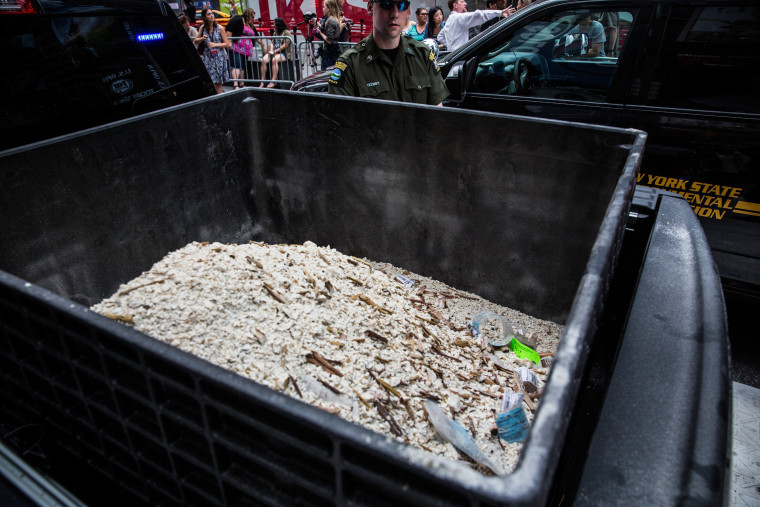Dead animal parts don’t usually take center stage in New York’s advertising-plastered Times Square. But that didn’t stop the U.S. Fish & Wildlife Service from putting on a show on Friday, feeding a ton of illegal ivory through a giant grinder.
The stunt by officials from USFWS and a blue-ribbon coalition of conservation groups was meant to call attention to the grisly trade in elephant parts.
“This lifeless pile of trinkets and decorative items and jewelry is a reminder of the millions of wild elephants that have been killed, and are being killed, and of their millions of progeny, which never will be,” said Dan Ashe, director of USFWS and the event’s self-styled emcee.
This story first appeared on msnbc.com.
“While we’re standing here, about six more elephants will die, maybe more, because they’re now going after the babies,” added Interior Department Secretary Sally Jewell. “We’re not just crushing ivory. We’re crushing the blood ivory market.”
Well, maybe.
While the Times Square “ivory crush” certainly captured attention—plumes of shattered bone wafting off the 50,000-pound crushing machine is a pretty good scene—its real value depends on whether that attention can be converted into serious policy changes.
That, and whether the message gets through to poachers, traffickers and craftspeople who bring the raw product to market.
Ivory crushes are not a new idea. Kenya took the first major stand against the trade back in 1989, torching 12 tons of elephant tusks in Nairobi National Park. More recently Gabon, the Philippines, Hong Kong and China have crushed more than 30 tons of the product. The U.S. held its first crush in Denver in 2013.
But despite the burns and crushes, the violence of the ivory trade has accelerated in recent years, decimating the African and Asian elephant populations. Every year another 10 percent of the herd is culled, leaving the largest land animal on earth on pace for a quick extinction.

Dr. Daniel Stiles—co-author of the United Nation’s 2013 report on the elephant slaughter—thinks he knows why. When a drug runner watched the Reagan administration incinerate a pile of confiscated marijuana, did he think it best to quit the business—or double his work load to feed a new hole in the market? By the same logic, according to Stiles, the poaching has increased on pace with the government's public show of crushing the supply.
"The public is demanding action,” Stiles wrote in a 2013 op-ed in the Guardian. “In response, USFWS will crush seized ivory—almost certainly sending a message to criminals that they had better step up their killing of elephants before all the ivory is gone.”
Leigh Henry, senior policy advisor for the World Wildlife Fund, one of the day’s sponsors, disagrees with Stiles. She thinks an “ivory crush” can speak to the public at large, decimating the illegal trade from the other end of the supply chain.
“No one thinks this crush is going to solve the problem,” she said, moments before the first carved tusk was dropped into the machine on Friday. But at the same time, there are a lot of people who still don’t understand that “behind every piece of ivory is a dead elephant,” she said.
And then there’s China.
As the crossroads for an estimated 70 percent of the world’s illegal ivory, there is no solution without Chinese participation. The head of China’s State Forestry Administration recently vowed to stamp out the country’s grisly trade. But he offered no timeline or plan for how this ban will be enforced.
That’s where the Times Square event comes in, said Henry: It was a diplomatic handshake in the form of public relations stunt.
It was also calculated to support President Obama’s pledge to eliminate the ivory market in the United States. Trade in ivory has been illegal since 1989, but existing ivory was grandfathered in, and continues to circulate. That gives poachers a way to introduce new ivory, by claiming that it’s old.
This summer, the Obama administration hopes to end that practice, promoting new regulations that will require sellers to prove the age of their ivory with actual paperwork, not just a promise.
At the same time, Congress is considering legislation that would toughen penalties for those caught selling ivory; send more help to Africa, where the war against poachers is fought first hand; and authorize sanctions against nations that continue to deal in ivory.
“Each year sees the disappearance of thousands of plant and animal species,” Pope Francis wrote in an encyclical released a day before the crush in Times Square. His words were read aloud on Friday by John Calvelli, executive vice president of the Wildlife Conservation Society.
“The great majority become extinct for reasons related to human activity,” the pope wrote. “We have no such right.”
